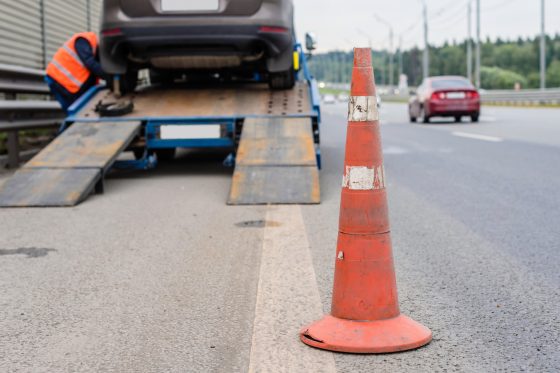A new online traffic control course aims to make working around traffic safer for towing and recovery operators.

Photo credit: iStock.com/FTiare
Workers in the towing and recovery industry spend a lot of their time working alongside moving vehicles. Whether they’re towing vehicles from an urban parking lane, assisting stalled drivers, or clearing vehicles from an accident scene, they need to know how to conduct a risk assessment and keep safe around traffic.
WorkSafeBC statistics show that between 2012 and 2021, 12 workers died on the job on B.C.’s roads. Between 2005 and 2019, another 15 tow truck operators were off work due to injuries sustained while working on or beside the road. (See my post Helping the auto recovery industry keep safety in tow, for more information.)
Recently I spoke with Ken Hendricks, towing and recovery advisor for B.C.’s Automotive Retailers Association (ARA) about a new online course, Emergency Response Traffic Control for Tow and Recovery Operators. It covers:
- Conducting a risk assessment
- Setting up and taking down traffic control equipment
- Using personal protective clothing and traffic control devices
- Having a buffer vehicle to protect the workplace
- Principles of traffic management outlined in the Traffic Management Manual for Work on Roadways
Ken says that you never know what situation to expect with towing. “A traffic scene can change very quickly, and it’s not a 9-to-5 job. Work happens at all hours and in all weather conditions.”
Traffic control is needed in many different situations
The course takes towing and recovery operators through a wide variety of situations they could likely encounter. For example, they may need to shut down a lane of traffic, work on the shoulder of a roadway, or recover vehicles in parking lanes. If they operate on a curve in the road or at the top of a hill, that adds risk.
“Typically, the bulk of work they need to do is emergent or brief. If a stalled car needs a boost, the operators are probably in and out of there in less than 15 minutes,” Ken says. He adds that even for short jobs, traffic control is often needed. “Beacon lights or their emergency lights may not be enough.”
For towing and recovery operators to be safe, drivers need to see them and have enough reaction time to slow down and move over. Managing risk at the worksite, including controlling traffic, helps workers conduct their job safely, and it also helps keep other drivers and those being assisted safe.
Once operators complete the online portion of the course, their employers test their knowledge with a practical test. The ARA course includes a checklist that employers can use as a guide. The course doesn’t provide certification as a traffic control person, but it covers what operators need to know for emergency scene management.
Updated safety for traffic control
In December 2021, amendments to Part 18, Traffic Control, of the Occupational Health and Safety Regulation improved safety for workers who control traffic in and around work zones, and those who work within a work zone. Tow truck and recovery operators are considered “emergency responders” — along with firefighters, paramedics, highway rescue workers, and others who play a critical role in emergencies where immediate action is needed to protect lives or prevent serious injury.
While each emergency scene is different, it is a workplace for everyone responding to it, and assessing risk to workers is required. (See WorkSafeBC’s webpage Managing risk.)
Thank you to Ken for talking with me about the new course — and to all towing and recovery operators who play such an important role in keeping us moving.


